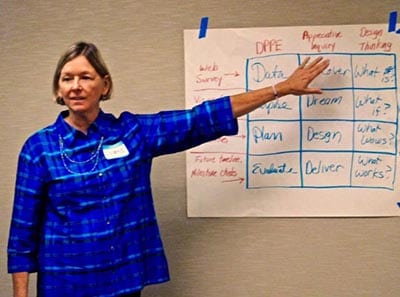By Jolene Knapp, Senior Partner at Ideas for Action, LLC.
By celebrating what’s right with the world, we find the energy to fix what’s wrong. Can we really do that at work? Yes! Whether you are talking with colleagues and students, orienting volunteers, or setting strategic direction with a board, an appreciative mindset can be transformative. With a basic understanding of a few principles, you can easily find practical ways to put this concept to use. The result is that people will create visions of possibility, and share in the refreshing knowledge that there are many paths to success. There’s more than one right answer!
Celebrating what’s right is the cornerstone of a powerful conversational framework called Appreciative Advising, which I practiced last month with 189 higher education professionals during an institute at Florida Atlantic University. It stems from Appreciative Inquiry (AI), an organizational development theory that “provides a positive rather than a problem-based lens on the organization, focusing members’ attention on what is possible rather than what is wrong.”
Appreciative Advising A basic tenet of Appreciative Advising mirrors a value I hold dearly: Let’s all proceed with the presumption of goodwill. It’s a great example of translating AI into a practical framework for a specific profession–in this case, academic advising. It’s effective because it is simple and flexible, not rocket science, with steps that can be implemented immediately in a variety of conversational settings. Here are a few possibilities. As described earlier, AI–when applied to organizations–provides a positive lens on the organization, focusing members’ attention on what is possible. It includes four of the phases of Appreciative Advising: Discover, Dream, Design, and Deliver. Similarly, it generates excitement and passion. Strategic Planning at Wayne State University Revamping a Program: Design Thinking is great tool to use when you’re creating or revamping a program or process. Its series of questions–What is? What if? What wows? What works? resemble the phases of AI. The process begins with developing deep empathy for the customer [user, student, member]. This first step is typically done through immersion, observation, and focus groups. Be the student who attends a class or the member who tries to volunteer for a committee. Watch the behavior of exhibitors and members at a trade show. Schedule structured conversations with all the stakeholders you can think of–current students or members, recruits, employers, accountants. Then, and only then, re-define the problem statement and begin imagining solutions–collaboratively. The best design comes from applying different lenses to a problem and welcoming a variety of perspectives. Acting from an appreciative mindset comes naturally to some people; others may need to work at it a little harder. With some structure and practice, there are countless ways to apply it. The results are priceless. Join the conversation by sharing your ideas and practices in the comments section below. To find out more about how an appreciative mindset can help you with strategy, facilitation, planning, projects, change, leadership, contact Jolene at jolenek@umich.edu. Jolene is a Senior Partner with Ideas for Action, LLC. Photo credits: Jolene Knapp and Deborah Nystrom
 Make room for “what if” conversations: “What if” is one of the most powerful questions imaginable. This is the time to dream. For a moment, pretend there are no obstacles like time, money, politics, or naysayers. Many years ago, a “what if?” conversation, while I was waiting in a buffet line with two fellow association CEOs, led to an unprecedented and highly successful joint annual conference among three major higher education associations. In fact, workshops, sessions, and speakers (in . . .yes . . . Honolulu) were centered around the what if theme of “Campus of the Future: A Meeting of the Minds”. A decade later, members are still talking about it.
Make room for “what if” conversations: “What if” is one of the most powerful questions imaginable. This is the time to dream. For a moment, pretend there are no obstacles like time, money, politics, or naysayers. Many years ago, a “what if?” conversation, while I was waiting in a buffet line with two fellow association CEOs, led to an unprecedented and highly successful joint annual conference among three major higher education associations. In fact, workshops, sessions, and speakers (in . . .yes . . . Honolulu) were centered around the what if theme of “Campus of the Future: A Meeting of the Minds”. A decade later, members are still talking about it. My colleagues and I apply an appreciative mindset to our consulting and coaching work in higher education and associations. Two organizational examples of AI reflect the elements of co-creation and of Design Thinking–a collaborative, and empathetic way to define problems and design solutions.
My colleagues and I apply an appreciative mindset to our consulting and coaching work in higher education and associations. Two organizational examples of AI reflect the elements of co-creation and of Design Thinking–a collaborative, and empathetic way to define problems and design solutions.

Appreciative Inquiry
Strategic Planning
Design Thinking
Discover
Data
What is?
Dream
Vision
What if?
Design
Strategic Priorities
What wows?
Deliver (and don’t settle)
Action and Assessment
What works?
 The author: Jolene Knapp is a Senior Partner at Ideas for Action, LLC.—a consulting practice driven by a passion to empower the potential of people and organizations. She is nationally known as a leader in association and non-profit management and governance. Her calm, positive, and inclusive style and her success in building, leading and sustaining membership organizations during constant change have earned broad respect in the industry. Jolene would welcome an introductory conversation with you: email info@ideasforactionllc.com.
The author: Jolene Knapp is a Senior Partner at Ideas for Action, LLC.—a consulting practice driven by a passion to empower the potential of people and organizations. She is nationally known as a leader in association and non-profit management and governance. Her calm, positive, and inclusive style and her success in building, leading and sustaining membership organizations during constant change have earned broad respect in the industry. Jolene would welcome an introductory conversation with you: email info@ideasforactionllc.com.

